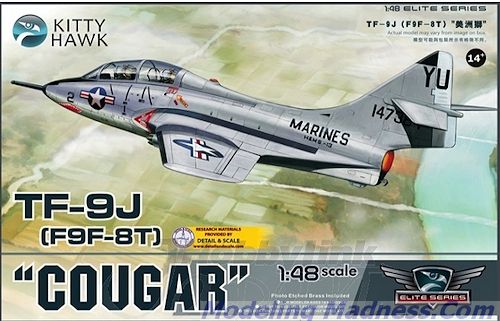
| KIT #: | KH 80129 |
| PRICE: | $ |
| DECALS: | Four options |
| REVIEWER: | Scott Van Aken |
| NOTES: | New tool kit |

| HISTORY |
The Grumman F9F/F-9 Cougar was an aircraft carrier-based fighter aircraft for the United States Navy. Based on Grumman's earlier F9F Panther, the Cougar replaced the Panther's straight wing with a more modern swept wing. The Navy considered the Cougar an updated version of the Panther, despite having a different official name, and thus Cougars started off from F9F-6 upward.
F9F-8s were withdrawn from front-line service in 1958-59, replaced by F11F Tigers and F8U Crusaders. The Naval Reserves used them until the mid-1960s, but none of the single-seat versions were used in the Vietnam War.
The only version of the Cougar to see combat was the two seat TF-9J trainer (until 1962, F9F-8T). Detachments of four Cougars served with US Marines Headquarters and Maintenance Squadrons H&MS-11 at Da Nang and H&MS-13 at Chu Lai, where they were used for fast-Forward Air Control and the airborne command role, directing airstrikes against enemy positions in South Vietnam during 1966 and 1968. The TF-9J had a long service with the U.S. Navy, but the proposed Cougar modification (reengined with a J52 engine) was rejected, and the Navy selected the TA-4F Skyhawk. The last Cougar was phased out when VT-4 re-equipped on February 1974. A F9F-8T, BuNo 147276, is displayed at the National Museum of Naval Aviation, Pensacola. There are several others extant in museums as well including the one at Pima, Arizona.
The only foreign air arm to use the F9F Cougar was the Argentine Naval Aviation, who used the F9F Panther as well. Two F9F-8T trainers were acquired in 1962, and served until 1971. The Cougar was the first jet to break the sound barrier in Argentina. Serial 3-A-151 is on display at the Naval Aviation Museum (MUAN) at Bahía Blanca.
| THE KIT |
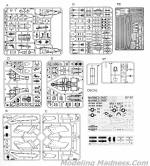 Many
of us have been awaiting this kit with much anticipation. The Cougar has not
been treated well in 1/48 with only the old Revell kit as well as a short run FM kit and a resin one by Collectaire being offered in the
past. Now Kitty Hawk starts with the two seater to be followed by the recce
version and I'm sure a standard fighting won't be far behind.
Many
of us have been awaiting this kit with much anticipation. The Cougar has not
been treated well in 1/48 with only the old Revell kit as well as a short run FM kit and a resin one by Collectaire being offered in the
past. Now Kitty Hawk starts with the two seater to be followed by the recce
version and I'm sure a standard fighting won't be far behind.
The kit is quite typical of Kitty H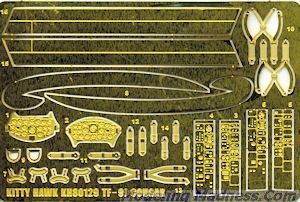 awk
moldings, which is to say that the detail is excellent. A photo etch fret is
included as per usual and is basically interior bits like seat harnesses, as
well as the wing fences and the upper wing speed brakes. Personally I could do
without the wing brakes as I always seem to bend those during installation!
awk
moldings, which is to say that the detail is excellent. A photo etch fret is
included as per usual and is basically interior bits like seat harnesses, as
well as the wing fences and the upper wing speed brakes. Personally I could do
without the wing brakes as I always seem to bend those during installation!
The kit has a very nicely done cockpit with two different seats provided. No information is given on which markings option gets which seat, but I'll bet that a 'net search will be helpful. Control sticks and rudder pedals are separate and you have photo etch for the instrument panels and consoles. In addition, you are provided with decals to go over these. I approve. Sidewalls are also part of the package.
One has to build up the nose gear well and the main gear well out of separate flat pieces, but they interlock well. The nose well assembly also includes the lower fuselage speedbrake well. It is quite normal to see these items bled down when the plane is on the ground. The nose well assembly fits under the cockpit assembly when the forward fuselage halves are glued together. A ball bearing was in my kit and I assume that is the nose weight as it is not shown in the instructions.
The rest of the fuselage is split horizontally and provides the opportunity to display the wings folded if one so chooses. There are nicely done spar sections to fit into the ends of both the main fuselage assembly and the outer wings. There are separate flaps for the wings and though not shown deployed, they were frequently seen that way when the plane was on the ground and the wings not folded. The kit is designed to be built with the wings folded and to do otherwise will require a bit of cutting. Something I wish KH wouldn't do is to already have the lower wing holes for the pylons opened. I'd much rather make that choice myself and not have to fill in holes that I won't be using.
In order to make most of the pieces usable for both two and single seat planes, the assembly of the rear fuselage requires the use of a lot of inserts. This will make things rather fiddly for some so care will need to be followed during the building of this section. The instructions show a fully built forward fuselage section and a fully built aft fuselage section (landing gear and doors and all) being assembled near the end of the build. Most of us will undoubtedly deviate from this interesting practice to protect parts from being broken during handling for painting. The canopy and windscreen are separate and the instructions only show the canopy closed. There is a mold seam on the canopy that will need to be sanded away. This was necessary to capture the proper shape.
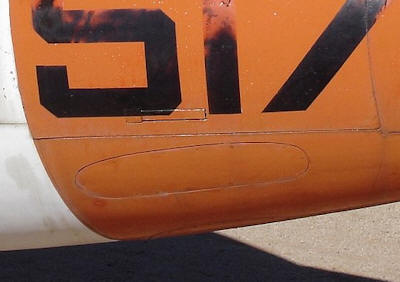 For
things under wings we have two fuel tanks, and then either Sidewinders or a
variety of rocket pods. For the non-FAC options, you'll not want the outer
pylons as these planes did not carry weapons. While on this subject, I do not
believe that most non-FAC planes had cannon either, as shown by this photo of
the nose of an F9F-8T at Pima. You will need to fill that area in if doing the
VT-10 or Blue Angel version. The Argentine aircraft did have the gun.
For
things under wings we have two fuel tanks, and then either Sidewinders or a
variety of rocket pods. For the non-FAC options, you'll not want the outer
pylons as these planes did not carry weapons. While on this subject, I do not
believe that most non-FAC planes had cannon either, as shown by this photo of
the nose of an F9F-8T at Pima. You will need to fill that area in if doing the
VT-10 or Blue Angel version. The Argentine aircraft did have the gun.
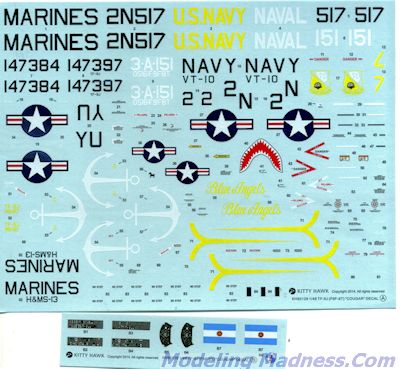 nstructions
are nicely done and provide Gunze and FS 595 paint references. Markings and
painting options are full color. Markings are provided for four aircraft. One is
the box art plane with H&MS-13 based in Vietnam which is shown as being in light
gull grey (FS 36440) over USAF light grey (FS 36622). I have my doubts about the
underside color as white would have been the usual shade, but one never knows.
Another is Blue Angel #7, while a third is with VT-10 in white and international
orange. In overall sea blue is an Argentine navy version. All of the latter
three planes are based on markings on museum aircraft. You can find images of
all these on the Internet. The decals are very nicely done and one will need to
paint any walkways onto the aircraft. The decals are very nicely done and any of
the options will result in a colorful model.
nstructions
are nicely done and provide Gunze and FS 595 paint references. Markings and
painting options are full color. Markings are provided for four aircraft. One is
the box art plane with H&MS-13 based in Vietnam which is shown as being in light
gull grey (FS 36440) over USAF light grey (FS 36622). I have my doubts about the
underside color as white would have been the usual shade, but one never knows.
Another is Blue Angel #7, while a third is with VT-10 in white and international
orange. In overall sea blue is an Argentine navy version. All of the latter
three planes are based on markings on museum aircraft. You can find images of
all these on the Internet. The decals are very nicely done and one will need to
paint any walkways onto the aircraft. The decals are very nicely done and any of
the options will result in a colorful model.
| CONCLUSIONS |
After what seems to be decades, Cougar fans will finally be getting a full run of their favorite plane in 1/48 scale. Personally, I think the two seat version is the best looking and I am looking forward to starting on mine. If most modelers are as jazzed about this one as am I, it should portend better things in the future.
| REFERENCES |
http://en.wikipedia.org/wiki/Grumman_Cougar
July 2014 Thanks to Glen Coleman and
Kitty Hawk
for the preview kit. You can find this one at your favorite hobby shop
or on-line retailer soon. If you would like your product reviewed fairly and fairly quickly, please
contact
the editor or see other details in the
Note to
Contributors.